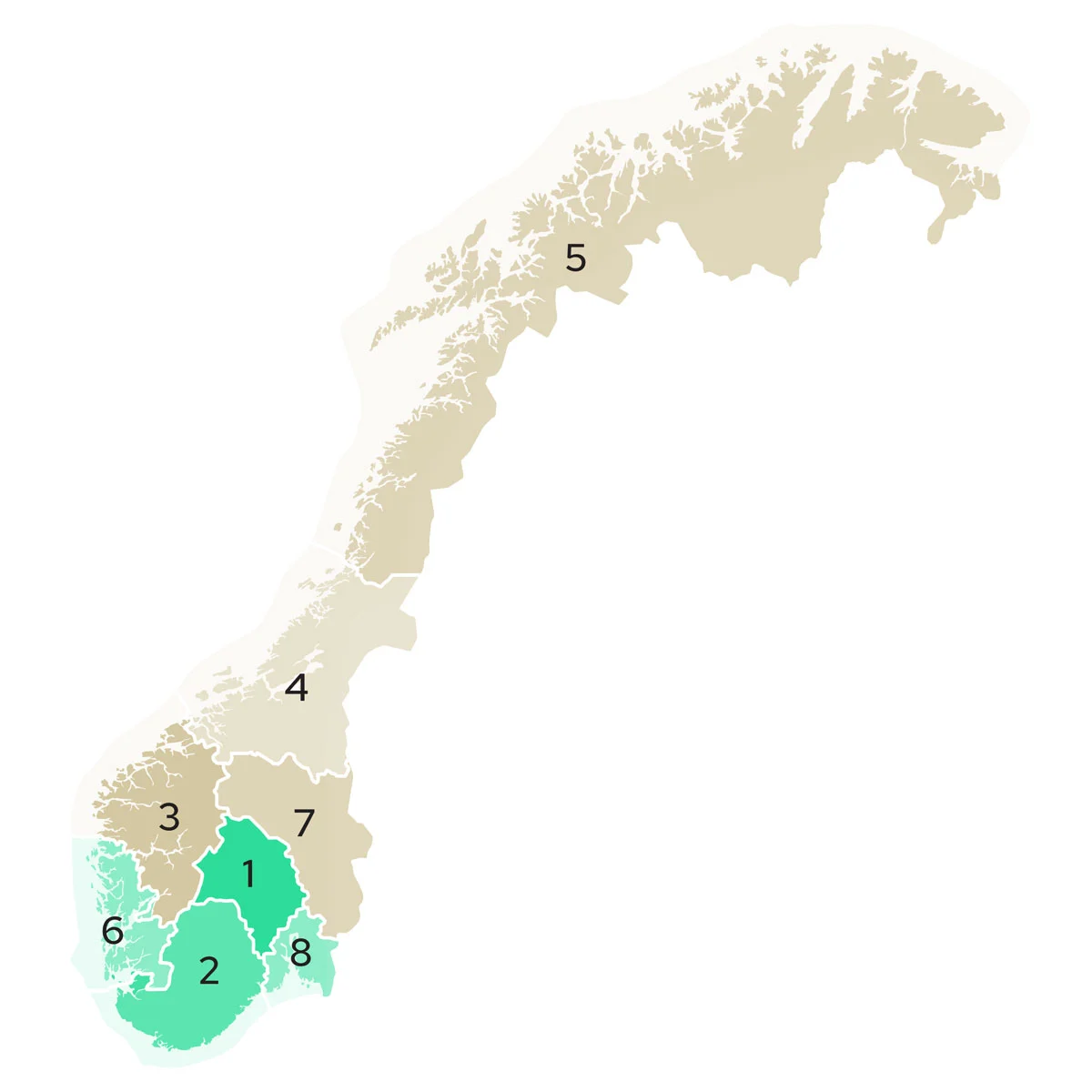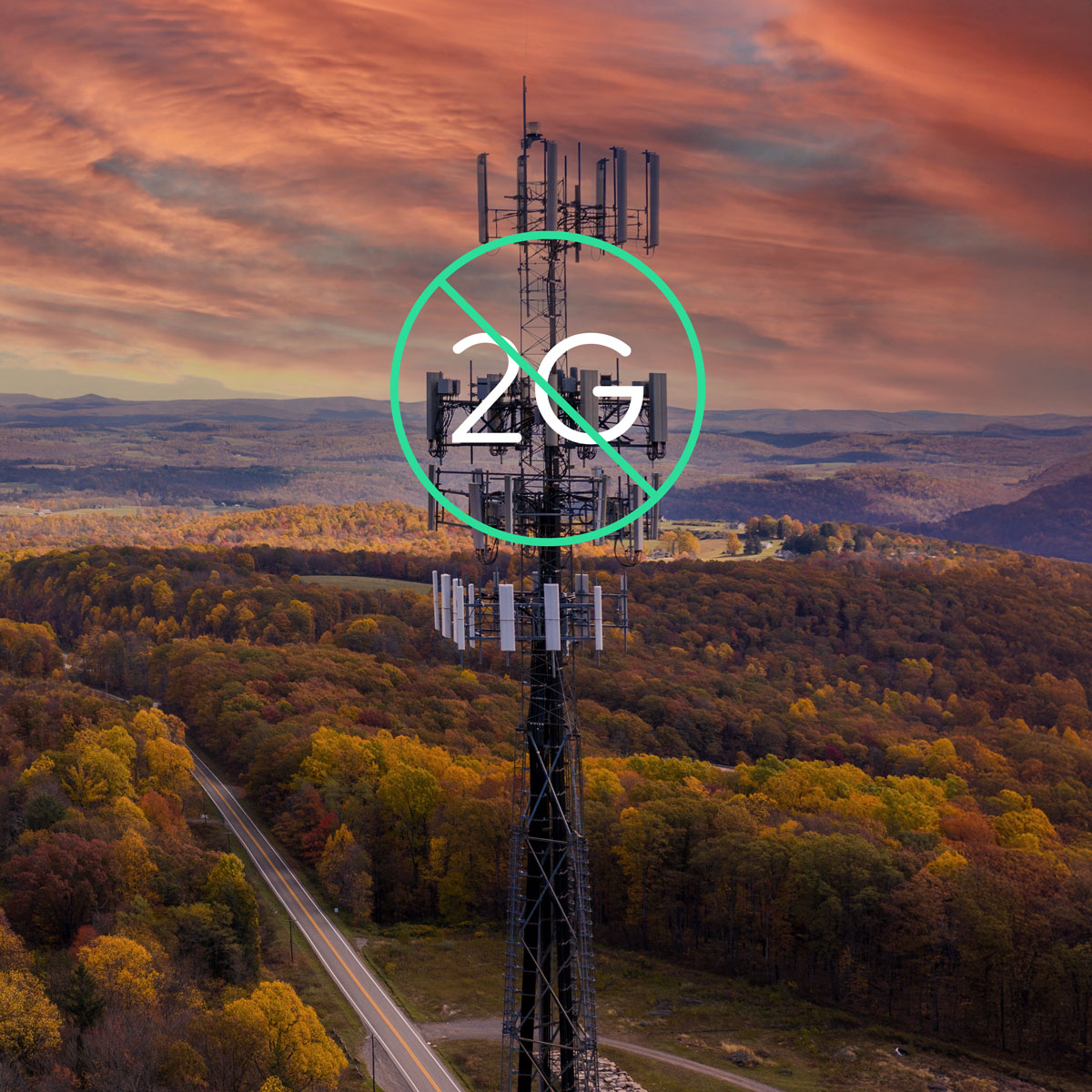At Com4, we work with enterprises that rely on mobile connectivity for everything from critical infrastructure monitoring to vehicle telematics and remote asset tracking. The upcoming 2G shutdown is more than a technical milestone, it is a strategic moment to evaluate and upgrade IoT deployments to take full advantage of the capabilities of modern networks such as LTE-M, NB-IoT, 4G, and 5G.
Norway: Telia begins 2G phase-out in autumn 2025
Telia Norway has confirmed that its national 2G shutdown will begin in August 2025, with Buskerud and parts of Innlandet being the first regions affected. The decommissioning will proceed in phases across the country, concluding by the end of December 2025.
The decision to retire the 2G network is driven by the need to modernise mobile infrastructure and reallocate valuable spectrum resources to more efficient and secure technologies. The 2G frequencies currently in use will be repurposed to expand capacity on the 4G and 5G networks, which now provide nationwide coverage and offer improved bandwidth, device density, and energy efficiency.
While most modern smartphones and mobile devices already operate on 4G or 5G, there are still many connected systems—especially within industrial and utility sectors—that rely on 2G for machine-to-machine (M2M) communication. These include legacy alarm systems, elevator communications, remote sensors, and older modems.
If such systems are not upgraded or replaced ahead of the shutdown, they will lose connectivity and cease to function once the 2G network is turned off.
Here is an overview of the areas affected and when:

August – Area 1 (August 19)
Buskerud (excluding the Drammen area) and the southwestern parts of Innlandet.
Area 2 (September 2) and Area 3 (September 16)
Telemark, Agder, and the southern parts of Rogaland (Area 2), the northern parts of Vestland, and the southwestern part of Møre og Romsdal (Area 3).
Area 4 (October 7) and Area 5 (October 21)
Trøndelag and the northeastern part of Møre og Romsdal (Area 4), Nordland, Troms, Finnmark, and Svalbard (Area 5).
Area 6 (November 4) and Area 7 (November 18)
Central and northern Rogaland, southwestern Vestland (Area 6), Innlandet and the northeastern part of Akershus (Area 7).
Area 8 (December 2)
Oslo, the Drammen area, Vestfold, Østfold, and the rest of Akershus (Area 8).
Swedish 2G shutdown end of 2025 (Telenor, Tele2) and end of 2027 (Telia)
In Sweden, the network joint venture Net4Mobility, operated by Telenor and Tele2, has announced that both the 2G and remaining 3G networks will be shut down on December 1, 2025. This marks the end of a long-planned phase-out, which has been in progress for several years.
According to Telenor and Tele2, the overwhelming majority of Swedish users—both individuals and organisations—have already migrated to newer technologies. However, businesses that still operate older equipment should urgently assess their device fleet and upgrade any systems that are not compatible with 4G or 5G.
Modernisation efforts across the Swedish mobile network have included a full replacement of network equipment since 2022. Net4Mobility’s 4G and 5G networks now cover more than 99.9% of the Swedish population, and a nationwide densification effort is underway, aiming to expand capacity by an additional 60%.
Telia has officially postponed the shutdown of its 2G network in Sweden until the end of 2027, extending the life of this aging technology to ensure a smoother transition for businesses and consumers—particularly those using IoT/2G devices in agriculture, alarm systems, heating, and other specialized equipment. Despite the delay, organisations relying on 2G should not wait until the last minute. We strongly recommend that customers verify with Com4 whether their devices—operating on Telia, Telenor, or Tele2 via the shared Net4Mobility infrastructure—will remain supported, or if firmware updates, SIM replacements or hardware upgrades are needed. Taking proactive measures now will help avoid last-minute disruptions and facilitate a seamless migration to 4G/5G connectivity.
The implications for IoT and M2M systems
The sunset of 2G represents a critical shift in how organisations connect devices in the field. While 2G has served as a reliable backbone for M2M communication for decades, it no longer meets the demands of today’s increasingly data-driven and security-sensitive use cases.
Devices and systems that will be affected include:
- Older mobile phones and modems that lack 4G or 5G support.
- Industrial and consumer alarm systems.
- Elevator emergency communications.
- Vehicle eCall systems.
- Sensors and meters in the energy and water sectors.
- Medical alert systems, often deployed in eldercare environment.
Without timely replacement, these systems will become inoperable once the network is decommissioned.
How Com4 helps you prepare
At Com4, we specialise in managed IoT connectivity. Our role is to ensure our customers are not only prepared for the 2G shutdown, but positioned to take full advantage of modern, future-ready technologies. We offer a range of connectivity options that are specifically suited to replace legacy 2G deployments:
- LTE-M: Ideal for mobile, low-power devices such as asset trackers, wearables, and logistics systems.
- NB-IoT: Designed for static, long-life deployments like smart meters and environmental sensors, especially where deep indoor penetration is needed.
- 4G and 5G: Suitable for high-data use cases and latency-sensitive applications such as video, autonomous systems, and complex industrial deployments.
In addition to providing the right SIM profiles and data plans, we also offer technical advisory services, helping customers assess their existing device inventory, test compatibility, and plan migrations efficiently—minimising both cost and downtime.
Key Dates and Deadlines
|
Country |
Network Operator(s) |
2G Shutdown Deadline |
|
Norway |
Telia |
Phased from August to December 2025 |
|
Sweden |
Telenor & Tele2 (Net4Mobility) Telia |
December 1, 2025 December 2027 |
Your next steps
If your organisation operates any equipment that may still depend on 2G connectivity, now is the time to start preparing for the migration. Many businesses underestimate the time required to test, certify, and roll out new IoT hardware at scale. Proactive planning can prevent disruption and open the door to more robust and efficient solutions.
If you're unsure whether your devices are compatible with newer networks, or if you need assistance planning your technology transition, we encourage you to get in touch with your Com4 representative. We are ready to support you through the transition with the tools, network access, and experience to make the shift as smooth as possible.
Com4 is your partner for resilient, future-proof IoT connectivity, today and tomorrow.

 CASE STUDY
CASE STUDY





.jpg)
.jpg)